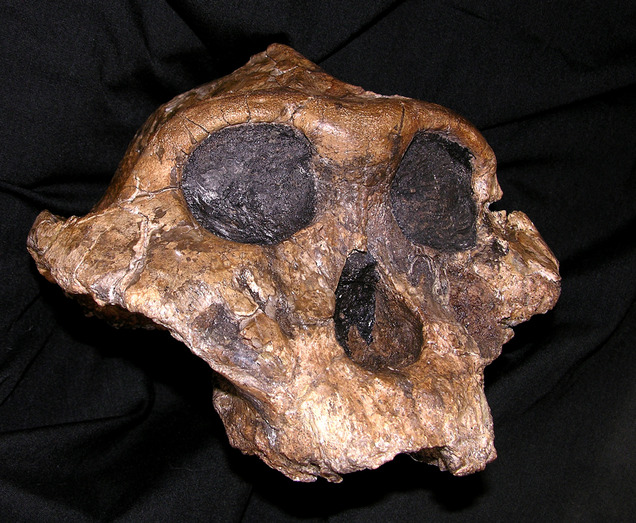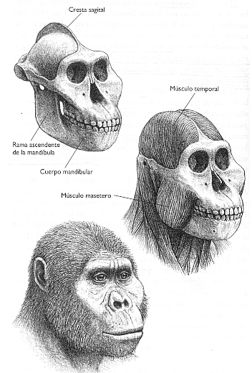
May 3, 2011



Paranthropus bust at the International Cryptozoology Museum, Portland, Maine.
Of the two schools of thought about what Bigfoot/Sasquatch might be, I come down on the Paranthropus side of the theories versus the Gigantopithecus one.
Now comes intriguing news that the original Paranthropus fossil find, which was called “The Nutcracker Man” didn’t eat nuts at all, but sedges or grasses.
New research by University of Utah geoscientists could overturn long-held views about an early human relative’s dietary choices in the East African savannah.
The teeth of the hominid Paranthropus boisei, first discovered by Mary Leakey in 1959 in Tanzania, are so big and flat, and the jaw so strong, that anthropologists wondered if the creature ate hard foods plucked from trees and nicknamed the species “Nutcracker Man.” That powerful face, however, was more likely built for chewing grass like a cow, according the research team’s findings.

The skull of Paranthropus boisei, known for decades as Nutcracker Man because of its large, flat teeth. Researchers from the University of Utah and other institutions are publishing a new study in which carbon isotope ratios in tooth enamel reveal that the early human relatives, which went extinct, likely used its big teeth and powerful jaw to chew grasses, but didn’t eat nuts. Credit: National Museums of Kenya.

This undated handout photo provided by the Proceedings of the National Academy of Sciences shows the casts of two palates demonstrates the large size of the teeth of Paranthropus boisei (left), an early human relative that lived in East Africa between 2.3 million and 1.2 million years ago and is known as Nutcracker Man. (AP Photo/Melissa Lutz Blouin, University of Arkansas)
Monday’s paper had University of Arkansas anthropologist Peter Ungar “grinning ear to ear” because it affirmed his theories about P. boisei based on physical examination of the big occlusal or chewing surfaces of its teeth, which revealed wispy scratches that are hardly consistent with hard foods.
“We weren’t sure what that diet was. They answered the question of what are the not-hard foods these guys were eating,” Ungar said.
The study’s authors included Emma Mbua, Francis Kirera and Fredrick Manthi of National Museums of Kenya; Frederick Grine of Stony Brook University; and anthropologists Matt Sponheimer of the University of Colorado and Meave Leakey.
BTW, I want to mention an aside about this business of the diet of Paranthropus, as pointed out by John Hawks at his outstanding anthropology weblog: “What were these extinct species really eating? Was grass the food? For living geladas, grass consumption includes seeds — a fact that led Clifford Jolly to suggest that early hominins might also have specialized on seeds. Of course, humans today also specialize on grass seeds. We call them grains, eat them in bread and drink them in soda. And beer.”
As I recall one of my favorite professors of anthropology at Southern Illinois University at Carbondale use to note, beer is one of the forgotten early secrets of the prehistoric human diet. Beer, Dr. Carroll Riley use to tell his students, might be older than bread. Perhaps Paranthropus drank old, disgusting, naturally fermented grains, which actually happened to be beer.
Nothing more exciting than thinking about Bigfoot and beer, probably. Maybe that explains some of their erratic behaviors?
The paper may have wide-ranging implications on other Paranthropus findings, hominology, and Sasquatch studies. Just saying.

Paranthropus aethiopicus Credit: Lesribalta.
About Loren Coleman
Loren Coleman is one of the world’s leading cryptozoologists, some say “the” leading living cryptozoologist. Certainly, he is acknowledged as the current living American researcher and writer who has most popularized cryptozoology in the late 20th and early 21st centuries.
Starting his fieldwork and investigations in 1960, after traveling and trekking extensively in pursuit of cryptozoological mysteries, Coleman began writing to share his experiences in 1969. An honorary member of Ivan T. Sanderson’s Society for the Investigation of the Unexplained in the 1970s, Coleman has been bestowed with similar honorary memberships of the North Idaho College Cryptozoology Club in 1983, and in subsequent years, that of the British Columbia Scientific Cryptozoology Club, CryptoSafari International, and other international organizations. He was also a Life Member and Benefactor of the International Society of Cryptozoology (now-defunct).
Loren Coleman’s daily blog, as a member of the Cryptomundo Team, served as an ongoing avenue of communication for the ever-growing body of cryptozoo news from 2005 through 2013. He returned as an infrequent contributor beginning Halloween week of 2015.
Coleman is the founder in 2003, and current director of the International Cryptozoology Museum in Portland, Maine.
Filed under Bigfoot, Breaking News, CryptoZoo News, Cryptozoology, Sasquatch